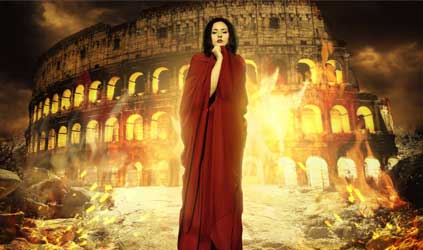September 17, 2016
Steve Sabz

Woman must choose between the devil or angel (Photo by HASLOO)
Did Jesus promise his disciples that they would be rescued out of the tribulation? Or, were they expected to endure and persevere through it?
And he will send out his angels with a loud trumpet call, and they will gather his elect from the four winds, from one end of heaven to the other.
Jesus Christ to his disciples in Matthew 24:31 (circa 50-60 AD)
The issue of whether or not Jesus would gather his elect before or after the tribulation is a hotly debated question among doomsday-rapture enthusiasts who espouse a futuristic interpretation of End Time Bible prophecy. In this article, we shall discover the correct answer and solve this rapture dilemma by examining relevant passages of Scripture. For the sake of argument, we will put aside the fact that a mass rapture, or catching up (1 Thessalonians 4:17), of believers into heaven is not even mentioned in the aforementioned passage. What is specifically described, is a gathering of believers out of harms way. This is not the same as the rapture event that the apostle Paul taught, but is erroneously interpreted as such by both pre and post-tribulation rapture adherents. Nonetheless, a table is provided below comparing the rapture and gathering.
The table below provides a comparison of the gathering of the elect described by Jesus (Matthew 24:31) and the catching up of those alive at Christ's bodily return as described by the apostle Paul (1 Thessalonians 4:17).
Rapture and gathering compared
|
| Rapture |
Gathering |
| no celestial events |
sun & moon darkened, heavens shaken (Mat 24:29) |
| Jesus himself descends from heaven (1Th 4:16) |
sign of Jesus appears in heaven (Mat 24:30) |
| dead in Christ rise first (1Th 4:16) |
dead in Christ absent |
| no angels sent out |
Jesus sends out his angels (Mat 24:31) |
| alive in Christ caught up [harpazo] (1Th 4:17) |
angels gather [episynago] elect (Mat 24:31) |
| meet the Lord in the air (1Th 4:17) |
no meeting in the air |
| Context: resurrection |
Context: tribulation |
Both of the aforementioned passages contain references to a trumpet (1 Thessalonians 4:16 & Matthew 24:31). Doomsday-Rapture proponents want to combine the passages on the basis that a trumpet is used as a signal to the rapture and gathering. However, this is fallacious since the context of the passages forces a distinction and separation of the two events. In addition, a trumpet is frequently used in the Bible as a signaling device for many different reasons (e.g., signal to approach the mountain, Exodus 19:13; the glorious presence of the Lord, Exodus 20:18; day of Atonement, Leviticus 25:9; signal for people to shout in battle, Joshua 6:5; at the anointing of King Solomon, 1 Kings 1:34; at the new moon, Psalm 81:3; to praise the Lord, Psalm 150:3; signal to listen, Isaiah 18:3; the alarm for war, Jeremiah 4:19; for approaching destruction, Jeremiah 6:1; used as a signal by hypocrites before giving to the needy, Matthew 6:2; the resurrection, 1 Corinthians 15:52; analogous to the voice of the Lord, Revelation 1:10; given to and sounded by seven angels, Revelation 8:2).
The first passage we will examine is Jesus' Olivet Discourse (Matthew 24:1-51). In it, the Lord tells his disciples that "Immediately after the tribulation of those days the sun will be darkened... And he will send out his angels with a loud trumpet call, and they will gather his elect from the four winds, from one end of heaven to the other" (Matthew 24:29-31). From a superficial observation, it would seem that a post-tribulation rapture interpretation of the passage is the correct one: The elect are gathered out after the tribulation. However, the true answer is a little more complicated. In order to discover the correct interpretation, a more thorough examination of the entire discourse is required.
The word "tribulation" (Greek thlipsis Strong's Lexicon G2347) is used three times in Jesus' Olivet Discourse according to Matthew. In the first instance, Jesus tells his disciples, "Then they will deliver you up to tribulation and put you to death" (Matthew 24:9). It is important to note that Jesus is speaking directly to his disciples here, and not to Christians living some 2,000 years later. The tribulation in this verse was to occur after "nation will rise against nation... famines and earthquakes in various places" (Matthew 24:7). This is plain to see since the Gospel writer uses the adverb "then" as opposed to the conjunction "and." We shall learn the importance of the absence of the adverb "then" in relation to the tribulation when we get to the third and final instance where the word "tribulation" is used.
The next passage where "tribulation" is mentioned is in Matthew 24:21. In order to grasp the context, let us first back up to Matthew 24:16, where Jesus tells his disciples to flee when they see the abomination of desolation. The abomination of desolation in this context is the surrounding of Jerusalem by armies as Luke clearly tells us (Luke 21:20). This was in order to escape the "great tribulation" (Matthew 24:21). Clearly, Jesus was giving his disciples a way to avoid the tribulation that was going to be caused by the surrounding of Jerusalem by Rome's pagan armies.
Now, we arrive at the passage of Scripture that is producing so much contention between pre and post-tribulation rapture theorists:
Immediately after the tribulation of those days the sun will be darkened, and the moon will not give its light, and the stars will fall from heaven, and the powers of the heavens will be shaken. Then will appear in heaven the sign of the Son of Man, and then all the tribes of the earth will mourn, and they will see the Son of Man coming on the clouds of heaven with power and great glory. And he will send out his angels with a loud trumpet call, and they will gather his elect from the four winds, from one end of heaven to the other.
Jesus Christ to his disciples in Matthew 24:29-31 (circa 50-60 AD)
Notice that the Gospel writer uses the conjunction "and" twice in the same sentence - "And he will send out his angels with a loud trumpet call, and they will gather his elect from the four winds, from one end of heaven to the other." The adverb "then" as was seen in Matthew 24:9 is not used. This means that the events are not sequential (i.e. tribulation, then Jesus sends his angels to gather the elect), but rather, a joining together of events in regard to the tribulation from which the disciples were instructed to flee to the mountains (Matthew 24:16). This may be a bit confusing at first, but it is important to invest more time observing the passage than being too quick to interpret it. Another way Matthew could have written it is: "when you see Jerusalem surrounded by armies, flee to the mountains to escape the tribulation... and Jesus' angels will gather you out." This simplified paraphrase does not violate the context.
Jesus' angels gathered the elect out of Jerusalem before being trapped inside by the Roman armies in much the same way they gathered Lot and his family out of Sodom before it was destroyed (Genesis 19:15-17). Recall that although Lot and his family were warned about the coming destruction, they nonetheless hesitated, prompting the angels to seize them by the hand and escort them outside the doomed city. If the disciples and the church in Jerusalem were expected to endure the tribulation, what would be the purpose in Jesus sending his angels to gather the elect out afterward? Surely, Jesus’ angels were not sent in order to gather the elect after suffering and dying in the tribulation.
According to the Jewish historian, Josephus (37-100 AD), 3 million Jews were trapped inside Jerusalem from 66 to 70 AD. After the war, 1 million were killed and almost another million were enslaved and deported. This leaves us with about a million elect (i.e., believers in Christ) Jews that would have been gathered out of the doomed city by the Lord’s angels before the war began.
This contextual interpretation is consistent with passages in the Revelation of Jesus Christ and the Book of Daniel where the elect living in ancient Jerusalem are promised to be delivered out of the tribulation (Daniel 12:1, Revelation 18:4), not to be destroyed in it. This fact is attested to by church historian, Eusebius (263-339 AD). These elect in Jerusalem are in contrast to the Christians "from every nation, from all tribes and peoples and languages" who would be conquered by the beast for forty-two months (Revelation 13:7), and suffer and die in the severe persecution perpetrated by Roman Emperor Nero from 64 to 68 AD (Revelation 7:9-14).
Another mistake by pre and post-tribulation rapture enthusiasts is the location of the tribulation. Both argue for a world-wide event far and beyond the land of Israel. However, the context reveals otherwise. A key to the location of the tribulation described in Jesus' Olivet Discourse is found in Matthew 24:16, where Jesus instructs "those who are in Judea flee to the mountains" in order to escape the tribulation. Another key to the location of the tribulation is where Jesus states that the "tribes of the earth will mourn." This is an obvious reference to the twelve, unregenerate tribes of Israel. They will mourn due to the destruction of their city and temple. In contrast, the elect would be called out of the tribulation coming upon first-century AD Jerusalem (Revelation 7:1-8, 18:4).
Thus, it seems that both pre and post-tribulation rapture theorists are incorrect in placing the tribulation mentioned in Jesus' Olivet Discourse some 2,000 years after it was already confirmed as fulfilled by secular and sacred historians in the first-century AD. Both pre and post-tribulation rapture proponents are equally guilty in distorting the text in one way or another as described in this article.
CITE:
Sabz, S. (2016, September 17). Before or after the tribulation? Retrieved from https://scienceandbibleresearch.com/before-or-after-the-tribulation.html
Steve Sabz
Steve Sabz is the author and founder of Science and Bible Research. He is a professional educator with a Bachelor of Science degree in Exercise Physiology from William Paterson University, where he also completed graduate level courses in Human Physiology and Endocrinology. Steve has been studying theology since 2015 and has successfully completed seminary level courses in Textual Criticism, Biblical Hermeneutics, Eschatology, Puritan Theology, Ancient Church History, Soteriology, Biblical Theology, Prolegomena, and Biblical Greek from Puritan Reformed Theological Seminary, Southern Baptist Theological Seminary, and Dallas Theological Seminary. Steve is also the author of Evolution's Complexity Problem: See How Evolution Falls Apart At Its Beginning and End Time Rewind: An Exploration In Bible Prophecy And The Fate Of The World.






